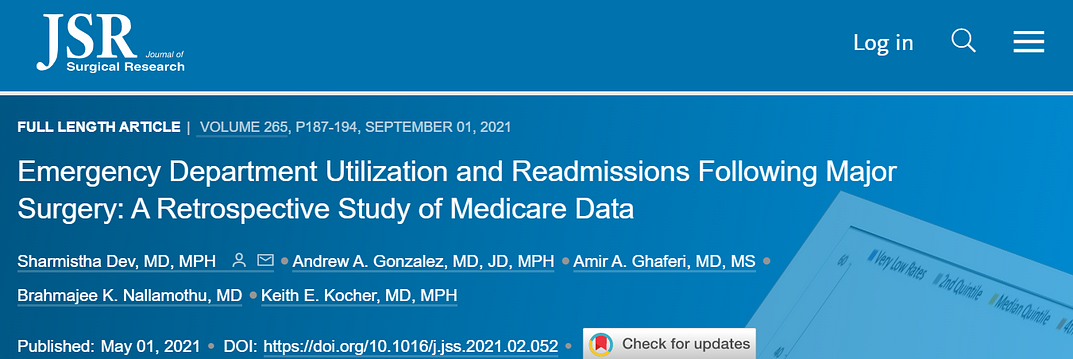Researchers analyzed the records of nearly 2 million Medicare beneficiaries who underwent one of five common surgical procedures.
HealthCareITNews
By Kat Jercich
December 08, 2021
Photo: Pixabay/Pexels
A study analyzing the electronic health records of nearly 2 million Medicare beneficiaries found that some hospitals are better than others at preventing post-surgical readmissions from the emergency department.
The study, published in the Journal of Surgical Research, sought to examine whether hospitals with high readmission rates also have high rates of post-discharge emergency department visits.
“Emergency departments are a significant factor in preventing readmission,” said lead author Dr. Sharmistha Dev, research scientist at the Regenstrief Institute. “Coordination of care should involve the ED.”
WHY IT MATTERS
As the authors note, reducing readmissions is a frequent priority for policy-makers and healthcare leaders.
The Centers for Medicare and Medicaid Services’ Hospital Readmissions Reduction Program, for example, reduces payments to hospitals for excess 30-day unplanned readmissions following certain conditions, including coronary artery bypass graft surgery and knee arthroplasty.
For the JSR study, researchers from the Regenstrief Institute, the U.S. Department of Veterans Affairs, Indiana University and University of Michigan conducted an analysis of
- 1,947,621 beneficiaries who underwent
- one of five common surgical procedures
- in 2,894 hospitals
- between 2008 and 2011.
The procedures included
- percutaneous coronary intervention,
- colectomy,
- hip replacement,
- coronary artery bypass grafting and
- aortic valve repair or replacement.
The team then compared rates of post-discharge ED visits, the proportion of patients readmitted from the ED, and readmissions within seven days of ED discharge.
Although risk-standardized, 30-day post-discharge readmission rates varied widely across hospitals, the rates of emergency department visits after surgery were fairly similar.
However, the proportion of patients readmitted from the emergency department was almost three times higher in hospitals with very high readmission rates, compared with those with low readmission rates.
… the proportion of patients readmitted from the emergency department was almost three times higher in hospitals with very high readmission rates …
But at the same time, hospitals with a low percentage of readmitted patients from the ED did not show an increased rate of readmission within seven days of ED discharge.
This suggests that some emergency departments and their affiliated providers may deliver care that prevents readmissions without an increased short-term risk of readmission following ED discharge.
“Our immediate next steps are to perform a deep dive into the practices of the best and worst performing hospitals and emergency departments,” explained Dev in a statement.
- “Is it increased communication between the ED and surgeons?
- Is it the existence of outpatient care plans?” she asked.
“Understanding those factors will help guide future interventions such as mobile health or telehealth,” she added.
THE LARGER TREND
Many healthcare organizations have relied on digital tools to reduce short-term hospital readmissions and improve outcomes.
For instance, a 2017 study found that use of a health information exchange reduced patients’ length of stay both in the emergency and inpatient departments.
And in 2018, a case manager at Legacy Salmon Creek Medical Center in Vancouver, Washington, created a new program that reduced all-cause readmission rates by nearly 25%.
ON THE RECORD
“Reducing 30-day readmissions requires greater attention to the coordination of care delivered in the ED,” observed researchers in the JSR study.
Kat Jercich is senior editor of Healthcare IT News.
Healthcare IT News is a HIMSS Media publication.
Originally published at https://www.healthcareitnews.com on December 8, 2021.
ORIGINAL PUBLICATION

VOLUME 265, P187–194, SEPTEMBER 01, 2021
Emergency Department Utilization and Readmissions Following Major Surgery: A Retrospective Study of Medicare Data
- Sharmistha Dev, MD, MPH
- Andrew A. Gonzalez, MD, JD, MPH
- Amir A. Ghaferi, MD, MS
- Brahmajee K. Nallamothu, MD
- Keith E. Kocher, MD, MPH
Published:May 01, 2021DOI:https://doi.org/10.1016/j.jss.2021.02.052
ABSTRACT
Background
Reliable strategies for reducing postoperative readmissions remain elusive. As the emergency department (ED) is a frequent source of post-operative admissions, we investigated whether hospitals with high readmission rates also have high rates of post-discharge ED visits and high rates of readmission once an ED visit occurs.
Methods
We conducted a retrospective analysis of 1,947,621 Medicare beneficiaries undergoing 1 of 5 common procedures in 2,894 hospitals between 2008 and 2011. We stratified hospitals into quintiles based on risk-standardized, 30-day post-discharge readmission rates (RSRR) and then compared rates of post-discharge ED visits, proportion readmitted from the ED, and readmissions within 7 days of ED discharge across these quintiles.
Results
RSRR varied widely across extremes of hospital quintiles (3.9% to 17.5%). Hospitals with either very low or very high RSRR had modest differences in rates of ED visits (12.4% versus 14.6%). In contrast, the proportion readmitted from the ED was nearly 3 times greater in Hospitals with very high RSRR compared with those with very low RSRR (12% versus 32.2%). These findings were consistent across all procedures. Importantly, hospitals with a low proportion readmitted from the ED did not exhibit an increased rate of readmission within 7 days of ED discharge.
Conclusions
Although hospitals experience similar rates of ED visits following major surgery, some EDs and their affiliated surgeons and health system may deliver care preventing readmissions without an increased short-term risk of readmission following ED discharge.
Reducing 30-day readmissions requires greater attention to the coordination of care delivered in the ED.
References
See original article
Originally published at




